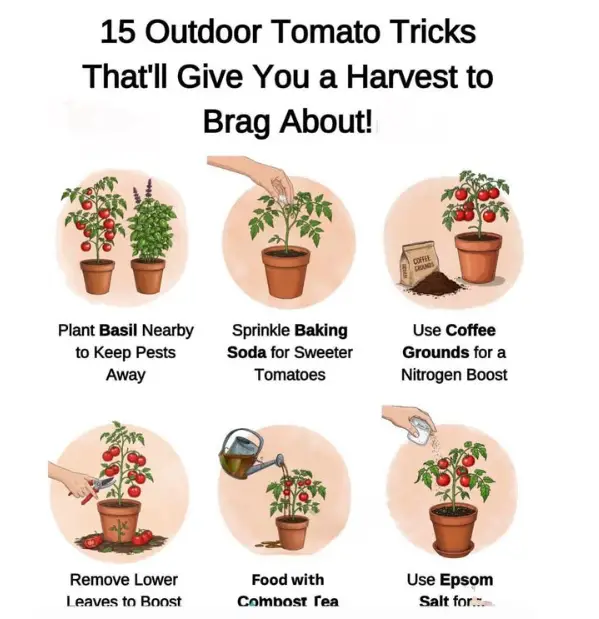Growing tomatoes outdoors can be incredibly rewarding when done with precision and care. With the right knowledge, even beginner gardeners can produce bountiful harvests of sweet, juicy tomatoes. Below are 15 proven techniques for optimizing your outdoor tomato growing season.
1. Choose Disease-Resistant Tomato Varieties
For outdoor success, opt for hybrid tomato varieties that are labeled with resistance to early blight (EB), late blight (LB), verticillium wilt (V), fusarium wilt (F1, F2), and nematodes (N). These resistances are commonly marked on seed packets and reduce crop loss dramatically. While heirloom tomatoes may lack explicit resistance labeling, proper pruning and airflow management can make them equally resilient in the garden.
2. Sow Tomato Seeds Early for a Head Start
Start your tomato seeds indoors during late February or early March. Use heated propagators or sunny windowsills to help seeds germinate in 7–10 days. Early sowing results in stronger, more mature plants that can handle the outdoor elements right after the last frost.
3. Harden Off Seedlings Gradually
Hardening off is critical for preventing transplant shock. Begin by exposing seedlings to the outdoors for 2-3 hours per day, increasing the time gradually over 10 days. Eventually, leave them outdoors from morning to evening, so they can acclimate to real sun patterns and fluctuating temperatures.
4. Buy Hardened-Off Tomato Seedlings
If you’re purchasing plants, look for outdoor-hardened tomato seedlings from local nurseries. These have already been exposed to natural weather, reducing the risk of stunted growth or sunburned leaves when transplanted.
5. Plant in Full Sun With Wind Protection
Tomatoes are sun-hungry plants. Choose the sunniest spot in your garden, ideally one that gets at least 6–8 hours of direct sunlight. Plant near walls or fences that reflect heat and block strong winds, creating a microclimate that enhances growth and protects foliage from wind-driven fungal spores.
6. Plant Tomato Seedlings Deep Into the Soil
To ensure strong root systems, remove the bottom sets of leaves and bury each plant up to just beneath the first set of true leaves. Planting deep not only strengthens root anchorage but also allows adventitious roots to form, leading to better nutrient uptake.
7. Space Plants Generously in Rows
Tomatoes require space to breathe and dry. Inadequate spacing invites mildew, mold, and blight. For optimal airflow, space indeterminate varieties 24–36 inches apart and determinates at 18–24 inches. Keep rows at least 36 inches apart to allow sunlight penetration and easy access for maintenance.
8. Practice Companion Planting for Natural Pest Control
Utilize natural pest deterrents by growing marigolds, basil, garlic, or nasturtiums near your tomato beds. These companion plants repel common pests such as aphids, whiteflies, and spider mites, while attracting pollinators. Basil is especially beneficial for enhancing tomato flavor and boosting nearby plant health.
9. Train Vining (Indeterminate) Tomatoes to Sturdy Supports
Weekly support is essential. Use tall stakes, trellises, or cages and secure vines with soft ties or plant clips. Regular tying prevents stem breakage from heavy fruit loads and reduces disease by lifting plants off damp soil.
10. Provide Gentle Support for Determinate Varieties
Determinate or bush tomatoes thrive with minimal but central support. Use a single bamboo cane or a tomato cage, allowing natural swaying in the wind to strengthen stems. This setup also enhances airflow through dense foliage, lowering the chances of fungal infections.
11. Feed Tomato Plants When Flowers Begin to Bloom
Once your tomato plants flower, switch from nitrogen-rich feeds to potassium-rich feeds like tomato fertilizer (e.g., tomato-tone, comfrey tea). Feed every 7–10 days to support fruit set, increase yield, and promote nectar production, which in turn enhances pollination.
12. Water Consistently, but Avoid Overwatering
Tomatoes dislike irregular watering. Water every 48 hours during dry spells, using a soaker hose or watering can at the base of plants. Always check soil moisture first—too much water leads to cracking fruit and root rot, while too little causes blossom end rot. Mulch around plants to retain moisture.
13. Prune Tomato Plants for Better Growth and Airflow
Pruning improves air circulation and reduces leaf crowding, both essential for outdoor plants. For cordon (indeterminate) tomatoes, remove side shoots (suckers) and bottom leaves as the plant matures. For determinate varieties, limit pruning to removing diseased or overlapping foliage.
14. Inspect for Pests Weekly
Be vigilant against aphids, whiteflies, hornworms, and spider mites. Look under leaves and along stems. Use neem oil, insecticidal soap, or manual removal to eliminate threats. Early detection of pests prevents disease spread, especially viral diseases that pests commonly transmit.
15. Expose Ripening Fruit to Direct Sunlight
As tomatoes begin to mature, remove some of the foliage around the fruit clusters. Reducing leaf cover by up to 50% in late summer allows sunlight and warmth to directly hit the fruit, speeding up the ripening process and enhancing flavor and sweetness.
Conclusion: Master the Art of Outdoor Tomato Growing
Success with outdoor tomatoes lies in consistent care, smart planning, and responsive gardening techniques. By following these 15 expert tips, we can cultivate a thriving tomato garden, resistant to common diseases, pests, and weather fluctuations. With proper pruning, spacing, and feeding, even modest gardens can yield impressive harvests of flavorful, healthy tomatoes.

